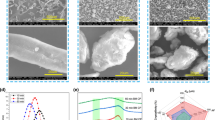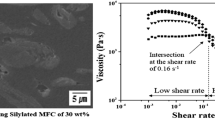Abstract
Microfibrillated cellulose (MFC)-reinforced polypropylene (PP) was prepared via two engineering approaches: disintegration of the pulp by a bead mill followed by a melt-compounding process with PP (B-MFC-reinforced PP); and disintegration of the pulp mixed with PP by a twin screw extruder followed by a melt-compounding process (T-MFC-reinforced PP). The effects that the engineering process and the microfibrillation of the pulp had upon the dispersion and mechanical properties were investigated through tensile tests, rheological analysis and X-ray computed tomography. The bead-milling method enabled a uniform microfibrillation of the pulp to under 100 nm, which corresponded to a surface area of 133–146 m2/g for the pulp, found by the Brunauer–Emmett–Teller (BET) analysis. The T-MFC-reinforced PP with 30 wt% MFC content exhibited a tensile modulus of 5.3 GPa and a strength of 85 MPa, whereas the B-MFC-reinforced PP composites with the same content of MFC exhibited values of 4.1 GPa and 59.6 MPa, respectively. Rheological analysis revealed that the complex viscosity and storage modulus at 170 °C of T-MFC-reinforced PP with 30 wt% MFC content are 5–7 and 5–8 times higher than that of B-MFC-reinforced PP, respectively. This indicated that T-MFC was more dispersed in the PP than B-MFC. Therefore, T-MFC produced a more rigid interconnected network in the matrix during the melting state than B-MFC.







Similar content being viewed by others
References
Abe K (2016) Nanofibrillation of dried pulp in NaOH solutions using bead milling. Cellulose 23(2):1–5. doi:10.1007/s10570-016-0891-4
Abe K, Iwamoto S, Yano H (2007) Obtaining cellulose nanofibres with a uniform width of 15 nm from wood. Biomacromolecules 8(10):3276–3278. doi:10.1021/bm700624p
Agarwal UP, Sabo R, Reiner RS, Clemons CM, Rudie AW (2012) Spatially resolved characterization of cellulose nanocrystal—polypropylene composite by confocal raman microscopy. Appl Spectrosc 66(7):750–756. doi:10.1366/11-06563
Aitomäki Y, Oksman K (2014) Reinforcing efficiency of nanocellulose in polymers. React Funct Polym 85:151–156. doi:10.1016/j.reactfunctpolym.2014.08.010
Bagheriasl D, Carreau PJ, Riedl B (2015) Properties of polypropylene and polypropylene/poly(ethylene-co-vinyl alcohol) blend/CNC nanocomposites. Compos Sci Technol 117(29):357–363. doi:10.1016/j.compscitech.2015.07.012
Bagheriasl D, Carreau PJ, Riedl B, Dubois C, Hamad WY (2016) Shear rheology of polylactide (PLA)–cellulose nanocrystal (CNC) nanocomposites. Cellulose 23(3):1885–1897. doi:10.1007/s10570-016-0914-1
Bahar E, Ucar N, Onen A, Wang Y, Oksüz M, Ayaz O, Ucar M, Demir A (2012) Thermal and mechanical properties of polypropylene nanocomposite materials reinforced with cellulose nano whiskers. J Appl Polym Sci 125(4):2882–2889. doi:10.1002/app.36445
Ben Azouz K, Ramires EC, Van den Fonteyne W, El Kissi N, Dufresne A (2011) Simple method for the melt extrusion of a cellulose nanocrystal reinforced hydrophobic polymer. ACS Macro Lett 1(1):236–240. doi:10.1021/mz2001737
Bondeson D, Mathew A, Oksman K (2006) Optimization of the isolation of nanocrystals from microcrystalline cellulose by acid hydrolysis. Cellulose 13(2):171–180. doi:10.1007/s10570-006-9061-4
Brunauer S, Emmett PH, Edward Teller E (1938) Adsorption of gases in multimolecular layers. J Am Chem Soc 60(2):309–319. doi:10.1021/ja01269a023
Cassagnau P (2013) Linear viscoelasticity and dynamics of suspensions and molten polymers filled with nanoparticles of different aspect ratios. Polymer 54(18):4762–4775. doi:10.1016/j.polymer.2013.06.012
Ching YC, Ali ME, Abdullah LC, Choo KW, Kuan YC, Julaihi SJ, Chuah CH, Liou NS (2016) Rheological properties of cellulose nanocrystal-embedded polymer composites: a review. Cellulose 23(2):1011–1030. doi:10.1007/s10570-016-0868-3
Cox HL (1952) The elasticity and strength of paper and other fibrous materials. Br J Appl Phys 3(3):72–79
Farahbakhsh N, Venditti RA, Jur JS (2014) Mechanical and thermal investigation of thermoplastic nanocomposite films fabricated using micro-and nano-sized fillers from recycled cotton T-shirts. Cellulose 21(4):2743–2755. doi:10.1007/s10570-014-0285-4
Favier V, Canova GR, Cavaillé JY, Chanzy H, Dufresne A, Gauthier C (1995) Nanocomposite materials from latex and cellulose whiskers. Polym Adv Technol 6(5):351–355. doi:10.1002/pat.1995.220060514
Fu SY, Lauke B (1996) Effects of fiber length and fiber orientation distributions on the tensile strength of short-fiber-reinforced polymers. Compos Sci Technol 56(10):1179–1190. doi:10.1016/S0266-3538(96)00072-3
Goffin AL, Raquez JM, Duquesne E, Siqueira G, Habibi Y, Dufresne A, Dubois P (2011) Poly (ɛ-caprolactone) based nanocomposites reinforced by surface-grafted cellulose nanowhiskers via extrusion processing: morphology, rheology, and thermo-mechanical properties. Polymer 52(7):1532–1538. doi:10.1016/j.polymer.2011.02.004
Hassanabadi HM, Alemdar A, Rodrigue D (2015) Polypropylene reinforced with nanocrystalline cellulose: coupling agent optimization. J Appl Polym Sci 132(24):2882–2889. doi:10.1002/app.42438
Henriksson M, Henriksson G, Berglund LA, Lindström T (2007) An environmentally friendly method for enzyme-assisted preparation of microfibrillated cellulose (MFC) nanofibers. Eur Polym J 43(8):3434–3441. doi:10.1016/j.eurpolymj.2007.05.038
Hietala M, Mathew AP, Oksman K (2013) Bionanocomposites of thermoplastic starch and cellulose nanofibers manufactured using twin-screw extrusion. Eur Polym J 49(4):950–956. doi:10.1016/j.eurpolymj.2012.10.016
Ho TTT, Abe K, Zimmermann T, Yano H (2015) Nanofibrillation of pulp fibers by twin-screw extrusion. Cellulose 22(1):421–433. doi:10.1007/s10570-014-0518-6
Iwamoto S, Kai W, Isogai A, Iwata T (2009) Elastic modulus of single cellulose microfibrils from tunicate measured by atomic force microscopy. Biomacromolecules 10(9):2571–2576. doi:10.1021/bm900520n
Iwamoto S, Yamamoto S, Lee SH, Endo T (2014) Mechanical properties of polypropylene composites reinforced by surface-coated microfibrillated cellulose. Compos Part A Appl Sci 59:26–29. doi:10.1016/j.compositesa.2013.12.011
Iwatake A, Nogi M, Yano H (2008) Cellulose nanofiber-reinforced polylactic acid. Compos Sci Technol 68(9):2103–2106. doi:10.1016/j.compscitech.2008.03.006
Jonoobi M, Harun J, Mathew AP, Oksman K (2010) Mechanical properties of cellulose nanofiber (CNF) reinforced polylactic acid (PLA) prepared by twin screw extrusion. Compos Sci Technol 70(12):1742–1747. doi:10.1016/j.compscitech.2010.07.00
Jonoobi M, Oladi R, Davoudpour Y, Oksman K, Dufresne A, Hamzeh Y, Davoodi R (2015) Different preparation methods and properties of nanostructured cellulose from various natural resources and residues: a review. Cellulose 22(2):935–969. doi:10.1007/s10570-015-0551-0
Khalil HA, Bhat AH, Yusra AI (2012) Green composites from sustainable cellulose nanofibrils: a review. Carbohydr Polym 87(2):963–979. doi:10.1016/j.carbpol.2011.08.078
Khoshkava V, Kamal MR (2014) Effect of cellulose nanocrystals (CNC) particle morphology on dispersion and rheological and mechanical properties of polypropylene/CNC nanocomposites. ACS Appl Mater Interfaces 6(11):8146–8157. doi:10.1021/am500577e
Klemm D, Kramer F, Moritz S, Lindström T, Ankerfors M, Gray D, Dorris A (2011) Nanocelluloses: a new family of nature based materials. Angew Chem Int Ed 50(24):5438–5466. doi:10.1002/anie.201001273
Krenchel H (1964) Fibre reinforcement. Alademisk Forlag, Copenhagen
Lee KY, Aitomäki Y, Berglund LA, Oksman K, Bismarck A (2014) On the use of nanocellulose as reinforcement in polymer matrix composites. Compos Sci Technol 105:15–27. doi:10.1016/j.compscitech.2014.08.032
Lindström T, Aulin C (2014) Market and technical challenges and opportunities in the area of innovative new materials and composites based on nanocellulosics. Scand J Forest Res 29(4):345–351. doi:10.1080/02827581.2014.928365
Liu Y, Yu Z, Zhou S, Wu L (2006) De-agglomeration and dispersion of nano-TiO2 in an agitator bead mill. J Dispers Sci Technol 27(7):983–990. doi:10.1080/01932690600766975
Ljungberg N, Bonini C, Bortolussi F, Boisson C, Heux L, Cavaillé JY (2005) New nanocomposite materials reinforced with cellulose whiskers in atactic polypropylene: effect of surface and dispersion characteristics. Biomacromolecules 6(5):2732–2739. doi:10.1021/bm050222v
Menezes AJ, Siqueira G, Curvelo AAS, Dufresne A (2009) Extrusion and characterization of functionalized cellulose whiskers reinforced polyethylene nanocomposites. Polymer 50(19):4552–4563. doi:10.1016/j.polymer.2009.07.038
Miao C, Hamad WY (2013) Cellulose reinforced polymer composites and nanocomposites: a critical review. Cellulose 20(5):2221–2262. doi:10.1007/s10570-013-0007-3
Morandi G, Heath L, Thielemans W (2009) Cellulose nanocrystals grafted with polystyrene chains through surface-initiated atom transfer radical polymerization (SI-ATRP). Langmuir 25(14):8280–8286. doi:10.1021/la900452a
Nishino T, Matsuda I, Hirao K (2004) All-cellulose composite. Macromolecules 37(20):7683–7687. doi:10.1021/ma049300h
Oksman K, Aitomäki Y, Mathew AP, Siqueira G, Zhou Q, Butylina S, Tanpichai S, Zhou X, Hooshmand S (2016) Review of the recent developments in cellulose nanocomposite processing. Compos A 83:2–18. doi:10.1016/j.compositesa.2015.10.041
Olsson RT, Samir MA, Salazar-Alvarez G, Belova L, Ström V, Berglund LA, Ikkala O, Nogués J, Gedde UW (2010) Making flexible magnetic aerogels and stiff magnetic nanopaper using cellulose nanofibrils as templates. Nat Nanotechnol 5(8):584–588. doi:10.1038/nnano.2010.155
Pääkkö M, Ankerfors M, Kosonen H, Nykänen A, Ahola S, Österberg M, Ruokolainen J, Laine J, Larsson PT, Ikkala O, Lindström T (2007) Enzymatic hydrolysis combined with mechanical shearing and high-pressure homogenization for nanoscale cellulose fibrils and strong gels. Biomacromolecules 8(6):1934–1941. doi:10.1021/bm061215p
Page DH, El-Hosseiny F (1983) The mechanical properties of single wood pulp fibres. J Pulp Pap Sci 9:99–100
Peng Y, Gallegos SA, Gardner DJ, Han Y, Cai Z (2014) Maleic anhydride polypropylene modified cellulose nanofibril polypropylene nanocomposites with enhanced impact strength. Polym Compos 37(3):782–793. doi:10.1002/pc.23235
Saito T, Kimura S, Nishiyama Y, Isogai Y (2007) Cellulose nanofibers prepared by TEMPO-mediated oxidation of native cellulose. Biomacromolecules 8(8):2485–2491. doi:10.1021/bm0703970
Saito T, Kuramae R, Wohlert J, Berglund LA, Isogai A (2012) An ultrastrong nanofibrillar biomaterial: the strength of single cellulose nanofibrils revealed via sonication-induced fragmentation. Biomacromolecules 14(1):248–253. doi:10.1021/bm301674e
Sakurada I, Nukushina Y, Ito T (1962) Experimental determination of the elastic modulus of crystalline regions in oriented polymers. J Polym Sci 57(165):651–660
Sato A, Kabusaki D, Okumura H, Nakatani T, Nakatsubo F, Yano H (2016) Surface modification of cellulose nanofibers with alkenyl succinic anhydride for high-density polyethylene reinforcement. Compos Part A 83:72–79. doi:10.1016/j.compositesa.2015.11.009
Segal L, Creely JJ, Martin AE, Conrad CM (1959) An empirical method for estimating the degree of crystallinity of native cellulose using the X-ray diffractometer. Text Res J 29(10):786–794. doi:10.1177/004051755902901003
Sehaqui H, Zhou Q, Berglund LA (2011) High-porosity aerogels of high specific surface area prepared from nanofibrillated cellulose (NFC). Compos Sci Technol 71(13):1593–1599. doi:10.1016/j.compscitech.2011.07.003
Semba T, Ito A, Kitagawa K, Nakatani T, Yano H, Sato A (2014) Thermoplastic composites of polyamide-12 reinforced by cellulose nanofibers with cationic surface modification. J Appl Polym Sci. doi:10.1002/app.40920
Suryanegara L, Nakagaito AN, Yano H (2009) The effect of crystallization of PLA on the thermal and mechanical properties of microfibrillated cellulose-reinforced PLA composites. Compos Sci Technol 69(7):1187–1192. doi:10.1016/j.compscitech.2009.02.022
Suzuki K, Okumura H, Kitagawa K, Sato S, Nakagaito AN, Yano H (2013) Development of continuous process enabling nanofibrillation of pulp and melt compounding. Cellulose 20(1):201–210. doi:10.1007/s10570-012-9843-9
Suzuki K, Sato A, Okumura H, Hashimoto T, Nakagaito AN, Yano H (2014) Novel high-strength, micro fibrillated cellulose-reinforced polypropylene composites using a cationic polymer as compatibilizer. Cellulose 21(1):507–518. doi:10.1007/s10570-013-0143-9
Suzuki K, Homma Y, Igarashi Y, Okumura H, Semba T, Nakatsubo H, Yano H (2016) Investigation of the mechanism and effectiveness of cationic polymer as a compatibilizer in microfibrillated cellulose-reinforced polyolefins. Cellulose 23(1):623–635. doi:10.1007/s10570-015-0845-2
Tanpichai S, Quero F, Nogi M, Yano H, Young RJ, Lindström T, Sampson WW, Eichhorn SJ (2012) Effective Young’s modulus of bacterial and microfibrillated cellulose fibrils in fibrous networks. Biomacromol 13(5):1340–1349. doi:10.1021/bm300042t
Tingaut P, Zimmermann T, Lopez-Suevos F (2009) Synthesis and characterization of bionanocomposites with tunable properties from poly (lactic acid) and acetylated microfibrillated cellulose. Biomacromolecules 11(2):454–464. doi:10.1021/bm901186u
Turbak AF, Snyder FW, Sandberg KR (1983) Microfibrillated cellulose, a new cellulose product: properties, uses, and commercial potential. J Appl Polym Sci Appl Polym Symp 37:815–827
Uetani K, Yano H (2010) Nanofibrillation of wood pulp using a high-speed blender. Biomacromolecules 12(2):348–353. doi:10.1007/s10570-012-9745-x
Wågberg L, Decher G, Norgren M, Lindström T, Ankerfors M, Axnäs K (2008) The build-up of polyelectrolyte multilayers of microfibrillated cellulose and cationic polyelectrolytes. Langmuir 24(3):784–795. doi:10.1021/la702481v
Wang Y, Forssberg E (2006) Production of carbonate and silica nano-particles in stirred bead milling. Int J Miner Process 81(1):1–14. doi:10.1016/j.minpro.2006.05.007
Acknowledgments
The authors thank Professor Humiaki Nakatsubo and Associate Professor Kentaro Abe of the Research Institute for Sustainable Humanosphere (RISH), Kyoto University, for helpful discussions. This study was supported by the New Energy and Industrial Technology Development Organization (NEDO), Japan; the Oji Holdings Corporation; Nippon Paper Industries Co., Ltd.; Mitsubishi Chemical, Corporation; the DIC Corporation and Sumitomo Rubber Industries, Ltd.
Author information
Authors and Affiliations
Corresponding author
Rights and permissions
About this article
Cite this article
Suzuki, K., Homma, Y., Igarashi, Y. et al. Effect of preparation process of microfibrillated cellulose-reinforced polypropylene upon dispersion and mechanical properties. Cellulose 24, 3789–3801 (2017). https://doi.org/10.1007/s10570-017-1355-1
Received:
Accepted:
Published:
Issue Date:
DOI: https://doi.org/10.1007/s10570-017-1355-1




